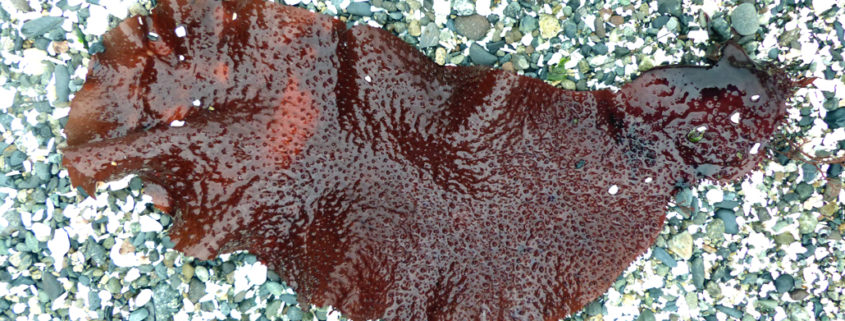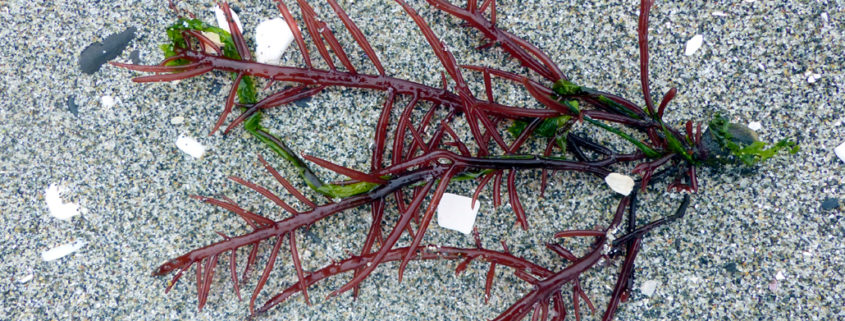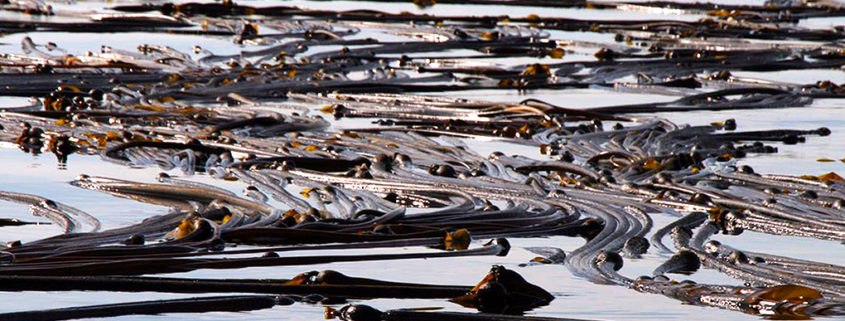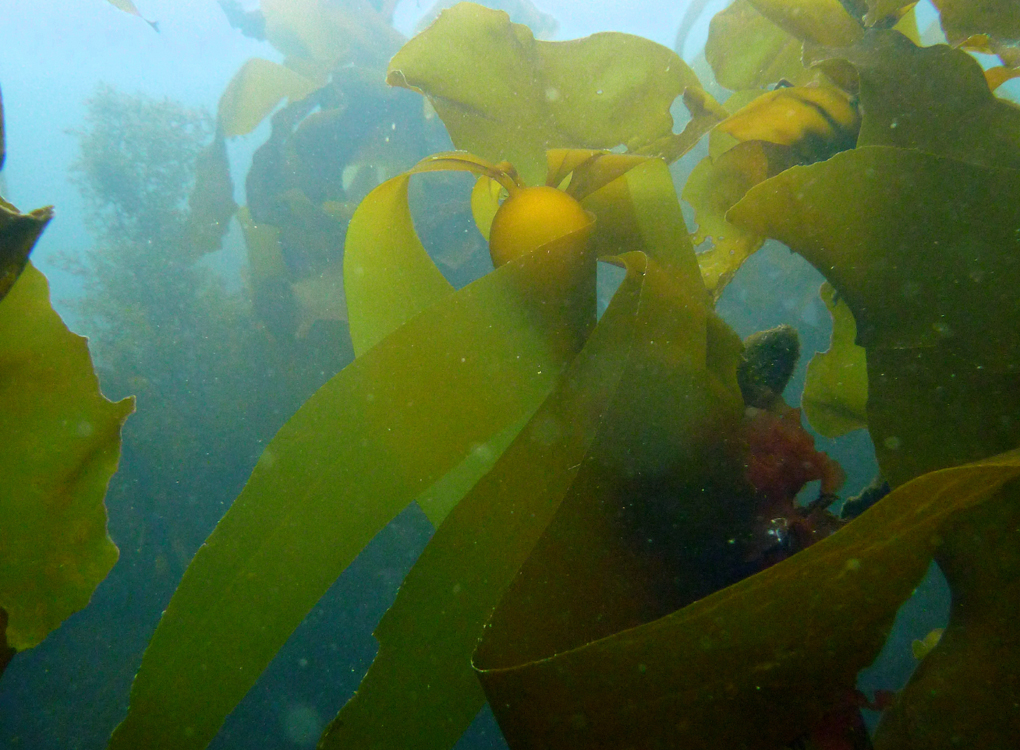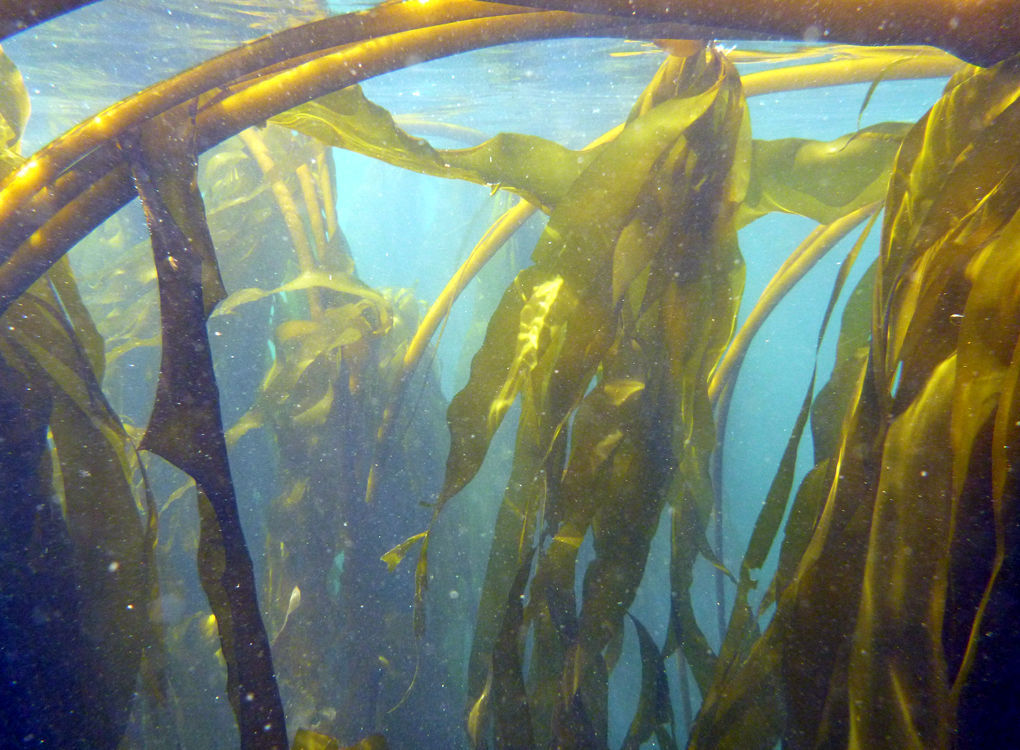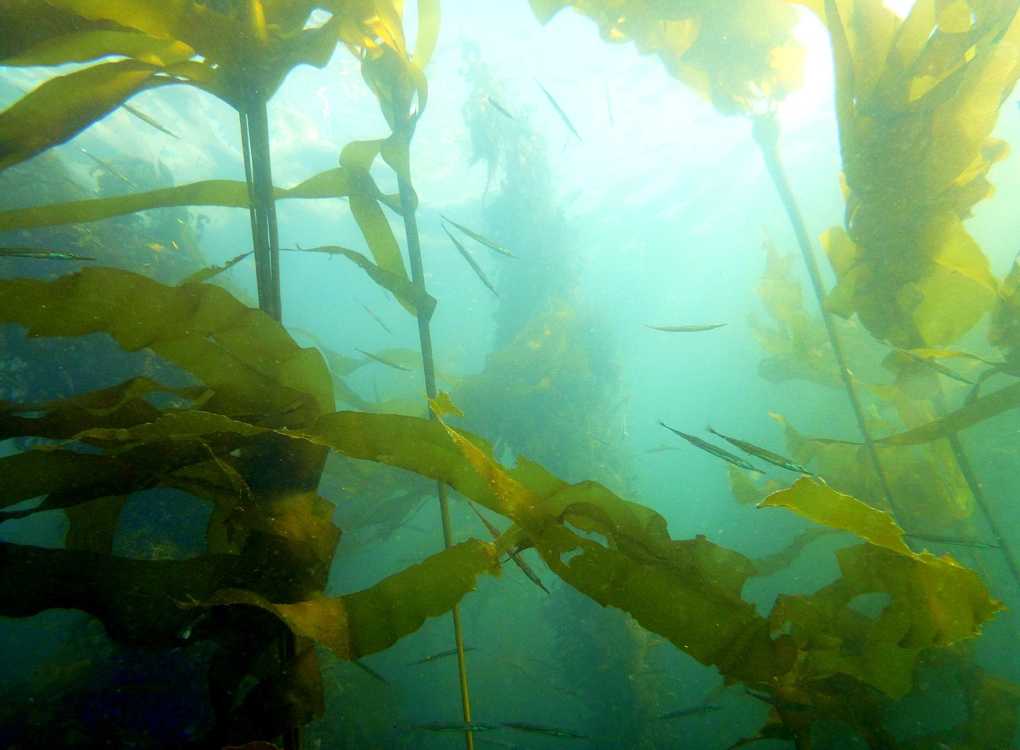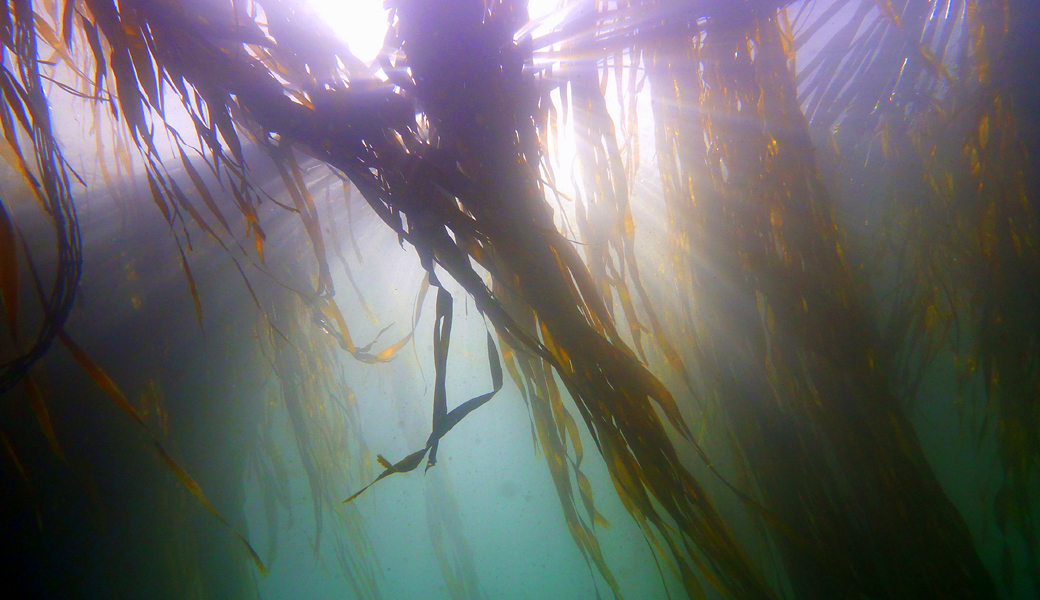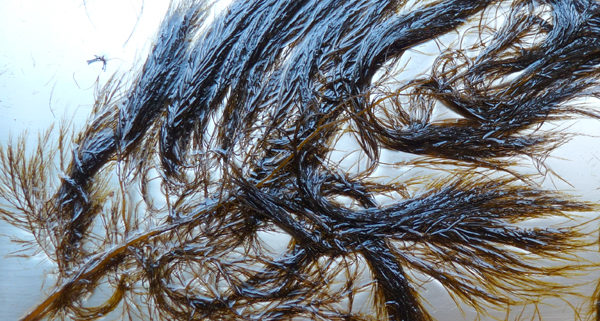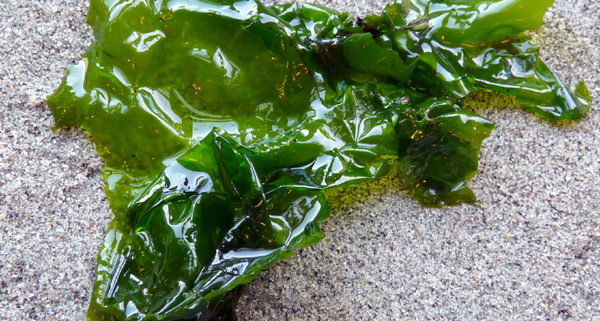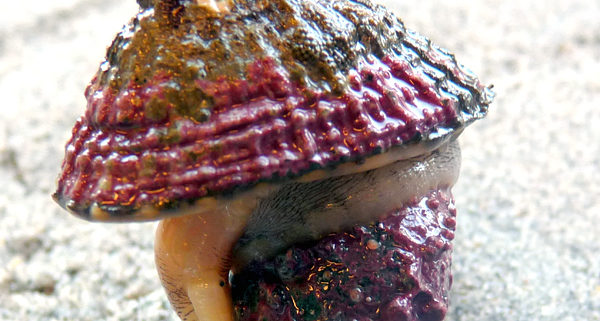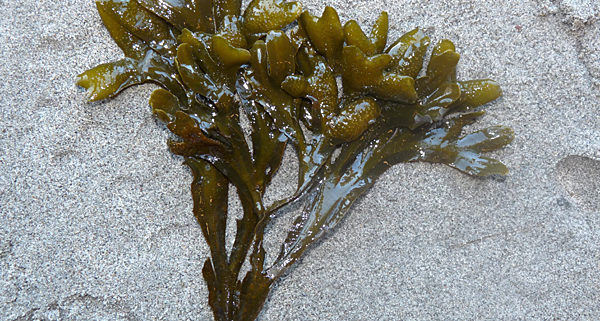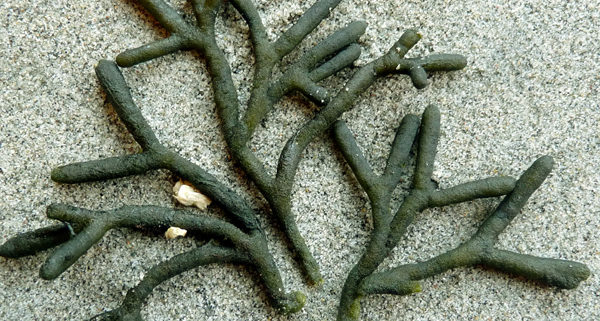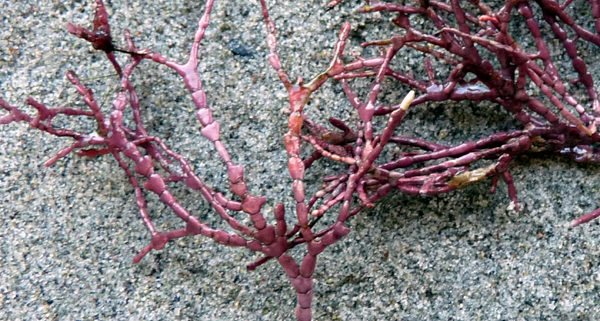Common name: Eelgrass Authors: Ares Bach, Thomas Woodruff, Kai Higgs Scientific name: Zostera marina Size : They are ¼” wide and can grow to 3 feet long. Identifying features: Long and bright green ribbon-like leaves. Cool facts: Z. marina will store nutrients and energy via rhizomes for required flowering in the spring and summer. They are one of the few marine plants that produce flowers. Eelgrass meadows reduce coastal erosion. They also provide refuge for juvenile salmon, spawning herring, Dungeness Crab, shellfish, migrating waterfowl and other marine animals. Habitat: The Eelgrass takes residence in a range of environments, from low intertidal pools, to subtidal areas, from Alaska to Mexico. References Dr. Bridgette Clarkson. (2015) A field guide to seaweeds of the pacific northwest. Pender Harbour: Harbour publishing. Kozlof, E. (1993) seashore life of the northern pacific coast: An illustrated guide to Northern California, Oregon, Washington, and British Columbia. Seattle, Washington: University of Washington Press.
Turkish Towel
Authors: Nathalie Douglas and Aleisha Evans
Scientific Name: Chondracanthus exasperatus
Size: They are able to grow to 1m tall and 30cm wide, but are more commonly 30-50cm tall and 10-20cm wide.
Habitat Turkish Towels live from Sitka Sound to Baja California on the west coast of North America. It is found in the upper subtidal zone to the lower intertidal zone, until a depth of 20m. It tends to grow on rocks in protected areas.
Identifying Features It is a red seaweed that is a single blade attached to a small stipe. It is rubbery and thick, with a towel-like texture from spikey papillae that cover the blade. The blade narrows at the top and is an irregular shape. The stipe may have some smaller (1cm) blades attached to it as well. Its colour ranges between purple, pink, dark red, light red, brown, and yellow green.
References
Feltham , Wendy. “Turkish Towel Seaweed – Gigartina Exasperata – Overview.” Encyclopedia of Life, EOL, 2012, eol.org/pages/902650/overview.
Fretwell, Kelly, and Brian Starzomski. “Turkish Towel • Chondracanthus Exasperatus.” Biodiversity of the Central Coast, 2014, www.centralcoastbiodiversity.org/turkish-towel-bull-chondracanthus-exasperatus.html.
Succulent Seaweed Author: Wanda De Simone Scientific name: Sarcodiotheca gaudichaudii Size: it grows 10-40 cm tall Identifying features: This species has cylindrical, rather brittle fronds that are radially branching and irregularly arranged. The colour varies from straw yellow to pale pink to reddish brown. The ultimate branches (2-3mm thick), are tapered to sharp tips. Habitat: This species inhabits lower intertidal to upper subtidal pools where it grows mainly on small stones near sandy areas. References: Fretwell, K. (2016). Biodiversity of the Central Coast, Sarcodiotheca gaudichaudii. Retrieved November 8, 2018 from http://www.centralcoastbiodiversity.org/sarcodiotheca-gau dichaudii.html Guiry, M.D. (1996). Sarcodiotheca gaudichaudii (Montagne) P.W. Gabrielson. Retrieved November 8, 2018 from www.algaebase.org/search/?genus=Sarcodiotheca&speci es=gaudichaudii Kozloff, E. (1993). Seashore Life of the Northern Pacific Coast. An illustrated guide to Northern California, Oregon, Washington, and British Columbia. Seattle, Washington: University of Washington Press.
Giant Bull Kelp Scientific name: Nereocystis leutkeana Author: Antonia Kropp Life History/ Interesting Facts: Bull Kelp is a major species of kelp and the largest brown algae. It is a fast growing seaweed that can grow up to 2ft in one day and reaches a total size up to 36m (118ft). Bull Kelp is a vital component of the coastal ecosystem and comparable to a forest on land. It is food and habit for many animals and other seaweeds. It has a large bulb filled with carbon monoxide gas at the end of a long, robust and flexible tail (called stipe), that keeps the kelp floating on the surface to get the sunlight it needs for photosynthesis. Most of the kelp dies in winter because of the stormy and rough weather and washes up on beaches where it serves as food and shelter for the animals on sandy shorelines. Habitat: Bull Kelp grows in kelp forests along the rocky coastline and in intertidal zone but not far off the coast it may be found in waters up to 20m (65ft) deep. It is common from northern Alaska to southern California (in colder water). As a result of its location near the coastline it can warn boaters of shallow reefs or the coast.

Common name: Witch’s Hair, Acid Kelp
Scientific name: Desmarestia aculeate
Size: it can grow up to 2 metres long
Habitat: It can be found on the Pacific coast, Bering Sea, Alaska, to Coos bay, Oregon. It commonly lives in pools and on rocks, in the low intertidal and sub tidal zones. They are commonly found washed up on the shore after storms and rough weather.
Identifying features: They are dark to light brown in colour. It is wiry and has strange branching patterns, and strongly resembles hair. It is connected to a small disc shaped holdfast. It releases sulfuric acid when it is damaged to ward off predators (it has been suggested that it should be avoided in seaweed collections since it could kill other seaweeds if it is left in the same container). Witch’s Hair may become quite prolific along floating docks in the Victoria area in the spring and many juvenile fish such as gunnels hide among it while they mature.
Scientific name: Ulva lactuca
Common name: Sea Lettuce
Size: The average size of the thallus is 16″ across though smaller specimens are common.
Identifying features: U. lactuca is an edible green algae that is widely distributed around the world. This seaweed is eaten my many animals such as manatees and sea slugs. This seaweed is also a food source for many humans around the world.
Cool facts: when it is decomposing it produces large amounts of sulphide gas that has caused many health concerns in Britain.
Pink Rock Crust (On Keyhole Limpet and Rock)
Common Name: Pink Rock Crust
Scientific Name: Crustose Corallines
Size: Greatly varies.
Identifying Features: Flat, various shapes of rough crust usually attached to rocks, shells, coral, seaweed etc. It is rough due to calcium carbonate in the cell walls of the plant.
Habitat: It can be spotted in subtidal and intertidal zones but may also occur in the deep ocean.
Rockweed Common name: Rockweed Habitat: Rockweed ranges from Alaska to California, high to mid intertidal. It dominates sheltered shorelines. Identifying Features: The Rockweed splits up into different branches, at the end of the branches there are little “popper” swellings. The branches are flat and split up into two different parts. The colouring can vary between green, brown and a yellowish tone. Reproduction: During low tide, the swollen tips dry up squeezing out sperm and eggs which unite into a zygote during the next flood tide and settle onto a substratum.
Scientific name: Fucus gardneri
Size: can range from 40- 20 cm (10-20 inches) long
Dead Man’s Fingers
Common name: Dead Man’s Fingers, Sea Staghorn
Scientific name: Codium fragile
Identifying features: This seaweed is dark green in color and appears as spongy tubular fingers.
Size: Up to 1 cm wide, and can extend to lengths of 10cm to 30 cm or more.
Habitat: Dead Man’s Fingers can be found in intertidal and subtidal zones. They can sometimes be found in permanently submerged tidepools attached to rocks using a green disc at the base.
Common Name: Coral Leaf Seaweed
Scientific Name: Calliarthron spp. and Bossiella spp.
Identifying Features: The reddish-pink thalli are hard having cell walls with calcium carbonate. It has uncalcified joints that allow it to flex and wave in the current. Dead specimens appear white resembling a skeleton.
Habitat: The coralline algaes similar to these species are common on rocky shore lines and around the rim of tidepools or in the cracks and crevices of large rocks and fissures.
Interesting resources for research and photographer credit
Latest Projects
VicHigh Marine
Victoria High School
1260 Grant St.
Victoria. BC, Canada
V8T 1C2
Phone: 250-388-5456
Email: dsyoung@sd61.bc.ca


